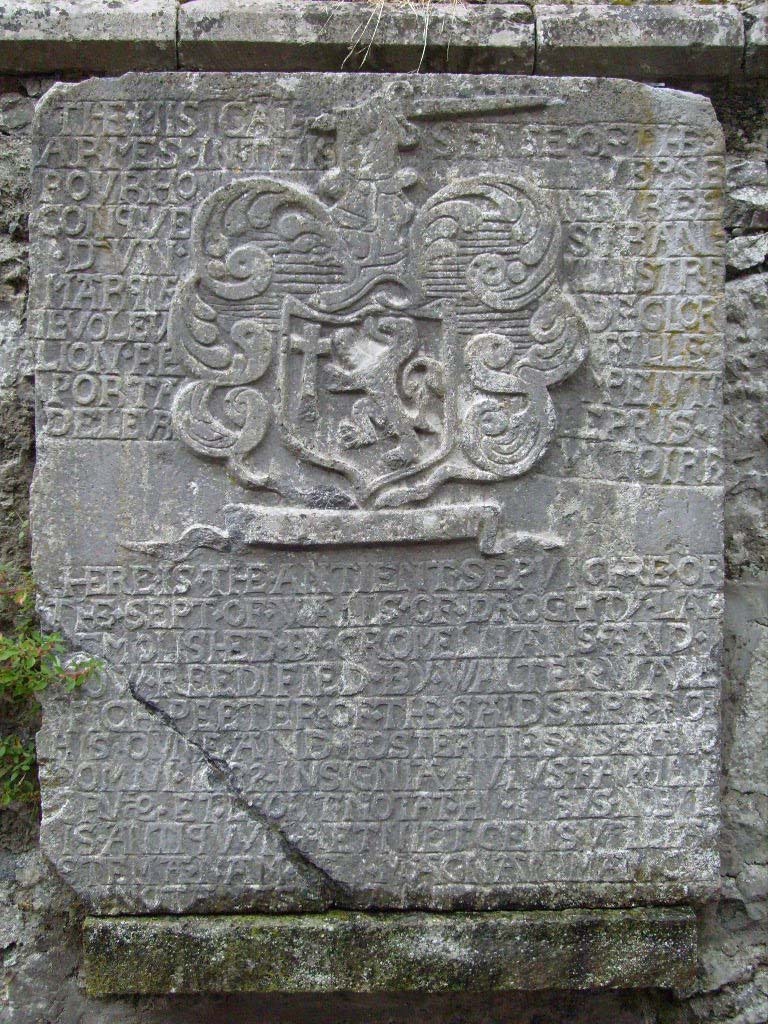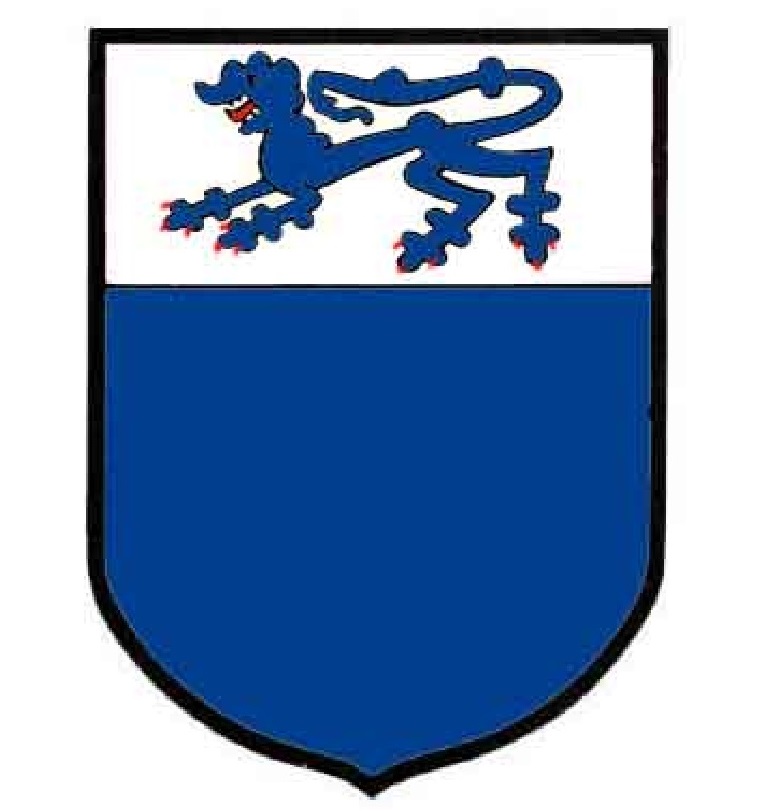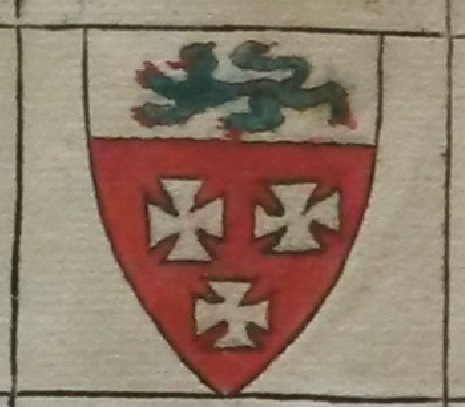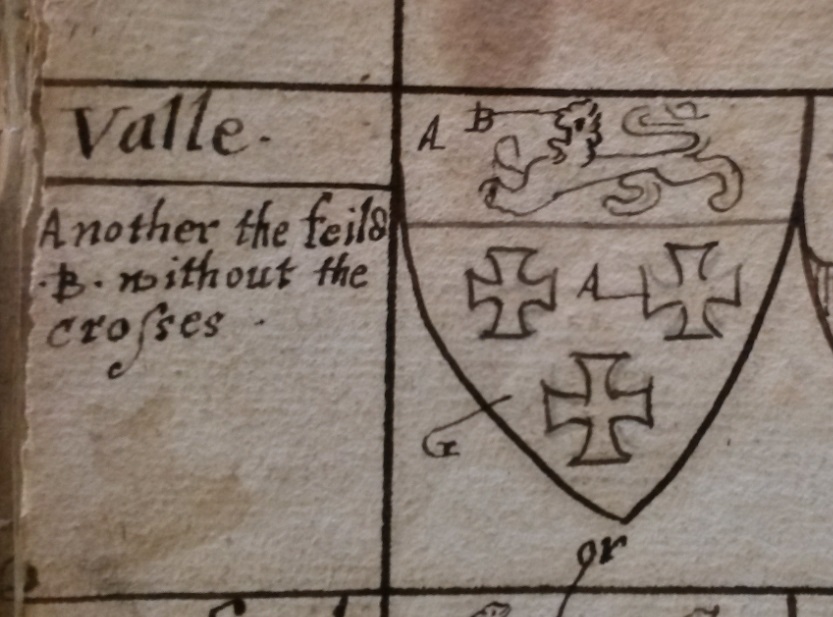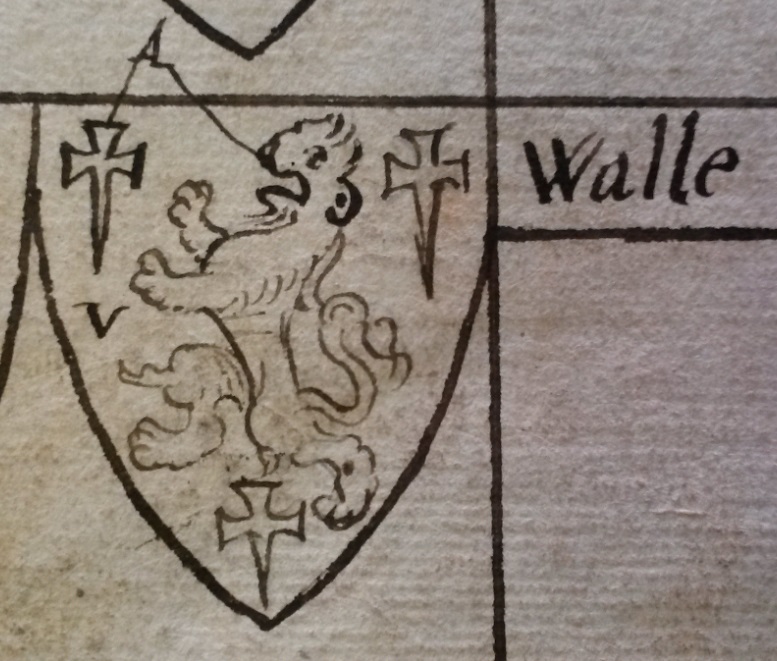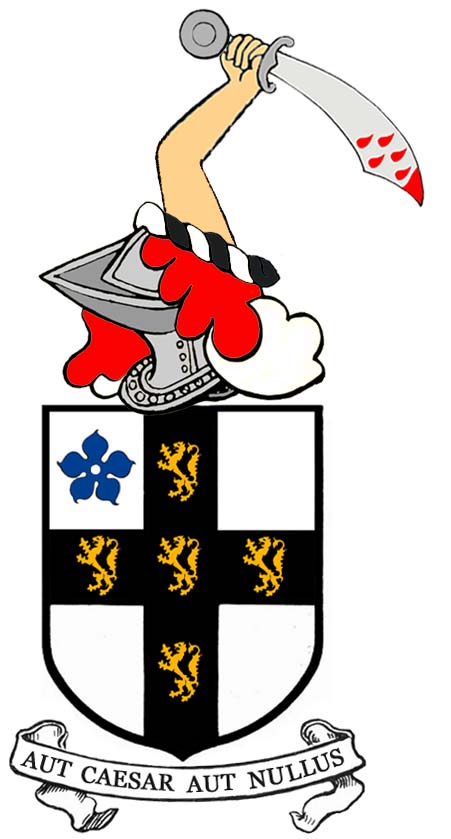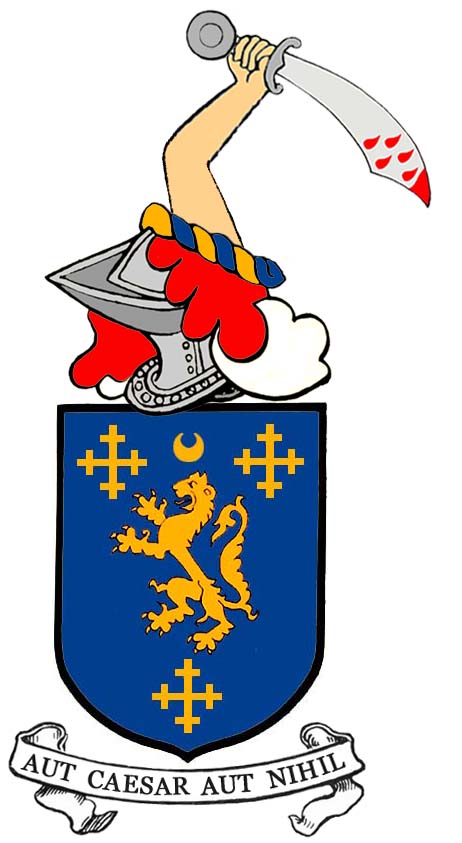© Donal G. Burke 2017
The de Valle or Wall family were of Anglo-Norman descent, but like the Burkes and the nearby Dolphins, had gradually become gaelicized in the later fourteenth and fifteenth centuries. By the later middle ages the head of the Wall family in Connacht was named among the ‘petty lords and captaines’ of the territory of Clanricarde in English documentation as ‘The Ffealtaghe’, an anglicised form of the Irish ‘An Fáltach’ or ‘The Wall’.[i] In the early seventeenth century the estates of the landed members of the family in County Galway were confined for the most part to the parish of Kilreekill which at that time was considered part of the half barony of Athenry.
From an early period senior members of the family were buried in the church of SS. Peter and Paul at the Dominican monastery of Athenry.[ii] The location of their burial place, about the north wall of the choir and and in close proximity to those of the Burkes of Clanricarde, the Berminghams and the Burkes of Derrymaclaughny, testifies to the prominent position held by the family in the territory about Loughrea and Athenry in the late medieval period.
The sepulchre of the principal family was ruined by the Cromwellians in the mid seventeenth century during their destruction of the church.[iii] A memorial tablet was erected in the church in 1682 by Walter Wall ‘fich Peeter’ (ie. Fitz Peter or ‘son of Peter’) in place of the former, depicting the armorial bearings of the family and describing the family in Gaelic terms as ‘the sept of Walls of Droghty’ (modern townland of Drought, parish of Kilreekill).[iv] The shield was dominated by a lion rampant, on the dexter side of which was placed a simple latin cross, the elongated shaft of the cross splayed outward slightly at base, the paws of the lion stopping short of holding the cross. Above the shield was shown a helmet in profile with closed visor and atop the helmet a dexter hand couped holding a sword, the latter placed fesswise. No tinctures were evident on the tablet and behind the shield was displayed cascading mantling typical of many seventeenth century Irish armorial tablets.
The tablet has been described as ‘the most remarkable of all the monuments in the church.’ The armorial bearing is surrounded by a contemporary inscription, rendered obscure by part of the lower lines being partly concealed by the early decades of the twentieth century and by its composition in a confused mixture of English, French and Latin, leading one commentator to suspect that the composer had not a sufficient knowledge of either French or Latin.[v]
The text, part of which appears to be a reference to the Wall arms and the symbolism of the cross and lion, is given by R.A.S. Macalister, who surveyed the church ruins about 1913 and held the French element of the composition to be an attempted quatrain;
“The mistcall (mystical) sense of the armes in this verse –
“pour honeur de conquestrant
et un illustre marque de glor
Il voleut qe le lion rempennt
Porta le pris de leur victoire.”
The text continues below the arms thus;
“Here is the antient sepulchre of the sept of Walls of Droghty lat demolished by Cromwellians and now reedified by Walter Wall fich Peeter of the said sept for his oune and posterities use, Ano Domni. 1682. Insignia hujus familie crux (or cruce) et leo et notat h—sus nbilis antiquum retniet gens Vallia stema nam leo magnanimam cu” (the following line thereafter indecipherable, the stone broken)[vi]
In the late twentieth century the Wall armorial stone was supported on a stone ledge and set against the north wall of the choir of the friary church, to the left of a triple-arched arcade-tomb. When R.A.S. Macalister visited the ruins of Athenry Friary about 1913 he recorded the Wall armorial stone as ‘built in under the central arch’ of this tomb, which would suggest that this now badly-defaced low arcade-tomb was that claimed by the Walls.
Gerard Crotty in his article ‘Heraldry in Medieval Ireland I: Prolegomena’, identifies several seals used in Ireland during the medieval period bearing the arms of members of the de Valle or Wall family. These are reflected to a degree in early and mid seventeenth century armorial manuscripts formerly held among the records of Ulster King of Arms and now part of the records of the Chief Herald of Ireland. The charge common to most of these examples is a lion passant in the chief of the shield. The earliest noted by Crotty is that seal of one Johnnes de Vale or John Wall, dated circa 1270. Although damaged, its shield consisted of a lion passant with forelegs obliterated occupying the chief or the upper half. That of Geoffrey de Valle appears to have been in use circa 1340 with a lion passant in chief and an obscured charge in base. That used in 1361 by Bernard de Valle bore a shield divided per fess, again with a lion passant in chief and with three narrow crosses formy in base, while a possible kinsman in Thomas de Valle made use about 1381 of a seal upon which shield the lion passant appeared again in chief but with the crosses formy replaced by the covered cups more often associated with the Butlers of Ormond. In this latter case Crotty was of the opinion that this may be a possible sign of household allegiance to the House of Ormond. An almost identical version of Bernard de Valle’s shield appeared again several centuries later but in stone and with a crudely carved lion passant guardant and no clear fess division line between chief and base in the impaled arms of Richard Wale of Rathkyny, gentleman and his wife Catherine Wale alias Carran on their 1635 memorial in the Augustinian abbey in Fethard, County Tipperary.[vii]
Two exemplifications of Wall arms appear in the manuscript now known as Genealogical Office Ms. 98 ‘Irish Arms, Smith Rouge Dragon 1613’. Both reflect those medieval seals detailed by Crotty; that described as the arms of Valle appear as ‘Azure, on a chief Argent a lion passant of the first.’ This shield again appears in the roughly contemporaneous Rawl. Ms. B69, known as ‘A Collection of the Armes of the Ierish Gentrie’ and in G.O. Ms. 38, known as ‘English Arms A, ca. 1590-1620′, but in this latter source with a chief Or. That shield described in G.O. 98 as the arms of Wall or Wale appear as Gules, three crosses formy, two and one, on a chief Argent a lion passant Azure. Both of these same arms are given as the shields of the name Valle in the mid seventeenth century G.O. Ms. known as ‘Carney Sketches of Arms’. The Carney manuscript also contains a tricked depiction of the arms of Walle as ‘Vert, a lion rampant between three crosses formy fitchee Argent’.
Arms of Valle after those depicted in G.O. Ms. 98, ‘Irish Arms, Smith Rouge Dragon 1613’.
Arms of Wall or Wale as depicted in G.O. Ms. 98, ‘Irish Arms, Smith Rouge Dragon 1613’. © NLI, Dublin.
Two different arms used by those surnamed Valle as given in G.O. Ms. 60 ‘Carney Sketches of Arms’., corresponding closely to those given in G.O. Ms. 55 and various medieval seals utilised in Ireland. © NLI, Dublin.
Arms of Walle as depicted in G.O. Ms. 60 ‘Carney Sketches of Arms’. © NLI, Dublin.
A pedigree registered by Hawkins Ulster in the office of Ulster King of Arms in 1716 gives several principal Wall families of Ireland as descended from one William Du Vall alias Wall, who accompanied Richard de Clare, Earl of Pembroke to Ireland in 1172 and who died in 1210.[viii] This source gives John Du Vall alias Wall of Johnstown, County Carlow, the son of this William Wall as having had four sons who each founded prominent families; William, ancestor of the Walls of Johnstown, County Carlow and of Kilcash and Rathkien (ie. Rathkynny or Rathkenny), County Tipperary; Walter of Droughty, County Galway, the second son, ancestor of the Walls of Coolnamuck, County Waterford; Richard, ancestor of the Walls of Dunmoylan, County Limerick and John, the fourth son, ancestor of the Walls of Ballymalty.
Hawkins Ulster was not noted for the accuracy of his genealogical pedigrees and two conflicting pedigrees survive from the same Ulster King of Arms relating to this same Wall descent. While the former is dated 1716, another earlier pedigree appears in G.O. Ms. 159 and gives the four brothers as the sons of the first William du Vall alias Wall, knight and made no reference to a John as father of the four brothers. Both pedigrees give Walter, the second eldest of the four brothers, as ‘of Droughty, County Galway.’ The earlier pedigree, however, gives Walter and the nine consecutive lineal descendants of Walter, as all seated at Droughty. Noticeably, none of their spouses, however, are from Connacht and derive from such places as Counties Waterford, Tipperary, Kilkenny and Carlow. The 1716 pedigree likewise gives the same spouses from the same locations but only gives the original Walter as ‘of Droughty, County Galway’ and gives the succeeding ten generations as ‘of Coolnemucky, County Waterford.’
At the introduction to the 1716 pedigree Hawkins attributed the removal of the Walls from Droughty to a dispute that arose during the lifetime of Richard de Burgh, the Red Earl of Ulster and Lord of Connacht, involving the original Walter Wall of Droughty which resulted in Wall quitting the lands of the Red Earl and settling at Coolnemucky or Coolnamuck within the lands of the Butler Earl of Ormonde, wherein his descendants remained seated thereafter.[ix] While members of the Wall family did come to be seated at Coolnamuck, Hawkins pedigree made no mention of the fact that members of the Wall family remained in possession of lands about Droughty or Drought in the parish of Kilreekill within what had been the lordship of the de Burgh Earls of Ulster into the early modern period.
The arms of the senior-most representatives of the various Wall branches were given in the 1716 pedigree. The arms of the first Wall in Ireland according to Hawkins pedigree was given as ‘Azure, a lion rampant between three cross crosslets Or’ and for crest ‘a naked arm holding a scimiter, the blade guttée de sang, all Proper’ and for motto ‘Aut Caesar aut nihil.’ These arms were inherited by the senior-most representatives of the senior-most line; the Walls of Johnstown. Twelve generations later, William Wall of Johnstown, eldest son of Edmund of the same place, was said by Hawkins to have ‘distinguished himself from the rest of the family by an alteration in his arms, coming to bear a shield ‘Argent, on a cross Sable five lioncels rampant Or, in the first quarter a cinquefoil pierced Azure,’ with the same crest as his ancestors but with a slightly altered motto of ‘Aut Caesar aut nullus.’ The impaled arms of William Wall of Johnstown, County Carlow, who died in 1620 were given in his funeral entry (N.L.I., Dublin, G.O. Ms. 66) with a shield Argent on a cross Sable five lions rampant Or, in the top dexter canton a cinquefoil pierced in the centre Azure. (This particular William Wall, however, did not appear in the Hawkins pedigree.)
The arms of William Wall of Johnstown, County Carlow, who, according to William Hawkins Ulster King of Arms, was the first to bear a shield ‘Argent, on a cross Sable five lioncels rampant Or, in the first quarter a cinquefoil pierced Azure.’ While Hawkins 1716 pedigree gave the crest simply as a naked arm Proper, Dr. Edward MacLysaght, first Chief Herald of Ireland, in his ‘Irish Families, Their Names, Arms and Origins,’ gave the crest as a naked arm embowed Proper.
The arms of Walter Wall of Drought, County Galway, ancestor of the Walls of Coolnemucky, and by inference of the Walls who remained at Drought, was given as the same as that of the first Wall in Ireland but differenced by a crescent, indicating Walter’s position as the second son.[x] It is not clear at what stage a crescent was applied in practice as the use of a more or less standardised system of cadency marks utilized labels, crescents, mullets and other marks is not believed to have come into being until about 1500.
The arms of Wall of Coolnemucky, County Waterford, bearing the crescent indicating descent from Walter Wall of Droughty, second son of John Wall of Johnstown.
The arms of Richard Wall, ancestor of the Dunmoylan Walls and those of John, ancestor of the Walls of Ballymalty, were both given as ‘Azure, a lion rampant between three crosses pate fitchee Or’ and for crest ‘a naked arm holding a sword, the blade guttée de sang, all Proper’ and for motto ‘Aut Caesar aut nihil.’[xi]
The arms utilized at Athenry by the Walls of Drought, however, differ from those associated with the families of the 1716 pedigree and surviving medieval armorial seals. While the arms of the principal family of Drought bear similarities to those of a Gaelic origin, the composition of the shield is almost identical to the crest utilized by members of the Wale or Wall family resident at one time at Shepton Mallet in Somerset, England.[xii] A similar crest was also attributed to families of that name living at various times in England at Bristol, Gloucestershire, Essex, Ably in Norfolk, Co. Rutland and Resby in Suffolk.[xiii] While the crest of the Shepton Mallet family was given as ‘a lion rampant Or holding a long cross Sable, the crest of the others was given as ‘a lion rampant guardant (i.e. with the lions head turned to look at the observer) Or supporting a long cross Or.’[xiv] In all of these cases, including that of Shepton Mallet, the composition of the shield was given as ‘Argent, on a cross Sable, five lions rampant Or.’ The Drought family crest bears some similarity to that attributed to those descendants of that William Du Vall who died in 1210, but the crest, however, also bears a similarity to that given by Robson in the eighteenth century generally as ‘Wall of Ireland’, who gives the arms as ‘Argent, on a cross Azure, voided of the field, five lions rampant Or’ and their crest as ‘an arm embowed in armour holding a sword Proper.’[xv] The hand holding the short sword on the Drought family crest appears to be naked.
For further details regarding this family, refer to ‘Wall’ under ‘families.’
[i] Hardiman, J., A Chronological description of West or h-Iar Connaught, written A.D. 1684 by Roderick O Flaherty Esq., author of the ‘Ogygia’, edited from a manuscript in the library of Trinity College Dublin, with notes and illustrations, Dublin, Irish Archaeological Society, 1846, p. 323-6.
[ii] Coleman, A., Regestum Monasterii Fratrum Praedicatorum de Athenry, Archivium Hibernicum, Vol. I, 1912, pp. 212-3.
[iii] The destruction of the burial place was recorded on the replacement memorial erected in place of the original; ‘Here is the antient sepulchre of the sept of Walls of Droghty…demolished by Cromwellians and re-edified by Walter Wall…’
[iv] Macalister, R.A.S., The Dominican Church of Athenry, J.R.S.A.I., Sixth Series, Vol. III, No. 3, 1913, p. 221.
[v] Macalister, R.A.S., The Dominican Church of Athenry, J.R.S.A.I., Sixth Series, Vol. III, No. 3, 1913, pp. 220-221.
[vi] Macalister, R.A.S., The Dominican Church of Athenry, J.R.S.A.I., Sixth Series, Vol. III, No. 3, 1913, pp. 220-221.
[vii] Crotty, G., Heraldry in Medieval Ireland I: Prolegomena, Peritia 24-25, (2013-4), pp. 313-347. Of this Rathkynny family, Mr. James Brennan informed the Journal of the Kilkenny and South East of Ireland Archaeological Society (Vol. IV, 1862-1863, Part 1, p. 147.) that at the time of writing (Ca. 1862) no trace then existed of the Wall or Wale family of Rathkynny ‘except for one branch now in low circumstances’.
[viii] Burke, B., The General Armory of England, Scotland, Ireland and Wales comprising a registry of armorial bearings from the earliest to the present time, Harrison and sons, London, 1884, Vol. III, p. 1066.
[ix] NLI, Dublin, G.O. Ms. 160, pp. 40-44.
[x] NLI, Dublin, G.O. Ms. 160, pp. 40-44.
[xi] Burke, B., The General Armory of England, Scotland, Ireland and Wales comprising a registry of armorial bearings from the earliest to the present time, Harrison and sons, London, 1884, Vol. III, p. 1066.
[xii] Burke, B., The General Armory of England, Scotland, Ireland and Wales comprising a registry of armorial bearings from the earliest to the present time, Harrison and sons, London, 1884, Vol. III, p. 1064.
[xiii] Burke, B., The General Armory of England, Scotland, Ireland and Wales comprising a registry of armorial bearings from the earliest to the present time, Harrison and sons, London, 1884, Vol. III, p. 1066.
[xiv] Burke, B., The General Armory of England, Scotland, Ireland and Wales comprising a registry of armorial bearings from the earliest to the present time, Harrison and sons, London, 1884, Vol. III, p. 1066.
[xv] Robson, T. (engraver), The British Herald or Cabinet of Armorial bearings of the nobility and gentry of Great Britain and Ireland, Vol. II, Sunderland, Turner and Marwood, 1850.


